DV :: 20NOV07 - 01MAY08 :: Syzygium ¿ aqueum / samarangense ?
Dinesh Valke
Manudev ji's query of how are Syzgium aqueum and Syzygium samarangense triggered me post these for ID.
After much of search on internet, my guess: Syzgium aqueum ... please validate.
Viewed at Native Place Resort, Kamshet, Near Lonavala ... 01 MAY 08
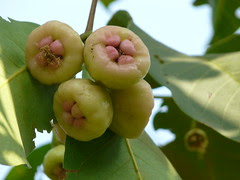
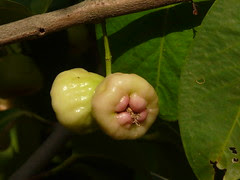
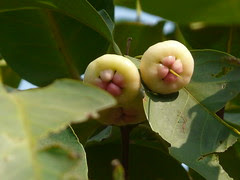
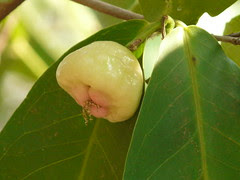
Viewed at MIDC Andheri ... 01 APR 08
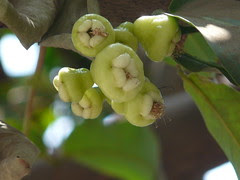

Viewed at MIDC Andheri ... 20 NOV 07
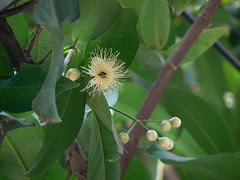

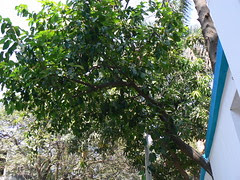

Regards.
Dinesh
Pudji Widodo
Perry. Although the last four pictures show only flowers with
relatively short stamens, but the leaves are still belonged to S.
samarangense. I may be wrong because in some cases there are some
intermediates between both samarangense and aqueum.
Regards,
Pudji Widodo
Fakultas Biologi Universitas Jenderal Soedirman
PURWOKERTO 53122 INDONESIA
http://pudji.widodo.blog.unsoed.ac.id/
Dinesh Valke
Would like to get know whether fruits of both species look similar to the extent that a plain person would not be able to differentiate them ?
Regards.
Dinesh
Dinesh Valke
At ftp://ftp.fao.org/docrep/fao/005/AC775E/ac775e09.pdf
Description:
... aqueum: 3–10m high with short crooked trunk, 30–50cm in diameter, often branching near base. Irregular crown. Leaves opposite, elliptic-cordate to obovate-oblong, 7– 25cm long, 2.5–16cm wide, with 0.5– 1.5cm long leafstalk, sometimes with aromatic smell when crushed. Inflorescence at tip of twigs or from leaf axils with 3–7 yellow-white flowers, 2.5–3.5cm in diameter, calyx 5–7mm long, 4 petals about 7mm long. Fruit cone-shaped, glossy white to red, 1.5– 2cm long and 2.5–3.5cm wide, watery with 1–2, sometimes 6 seeds.
... samarangense very similar but is somewhat larger, has thick, 3–5mm long leaf stalks, 15mm long calyx and larger pyriform fruits. Improved cultivars have green fruits. Leaves always aromatic smelling.
Key characteristics: Trunk short, crooked, often branching from base; crown irregular; leaves opposite; flowers yellow-white;
... aqueum: 5–15 mm long leafstalk and 5–7mm long calyx, small fruits;
... samarangense: 3– 5mm long leaf stalk, 15mm long calyx and larger fruit; aromatic
xxxxxxxxxxxxxxxxxxxxxxxxxxxxxxxxxxxxxxxxxxxxxxxxxxx
At World Agroforestry Centre ... It is not easy to distinguish between the various S. aqueum and S. samarangense fruits.
however:
The wax jambu is glossy - indeed wax-like - and the flesh is rather dry.
http://www.worldagroforestrycentre.org/sea/Products/AFDbases/AF/asp/SpeciesInfo.asp?SpID=18099
The water apple is a watery, thirst-quenching fruit with a glistening, almost translucent skin.
http://www.worldagroforestrycentre.org/Sea/Products/AFDbases/AF/asp/SpeciesInfo.asp?SpID=18097
xxxxxxxxxxxxxxxxxxxxxxxxxxxxxxxxxxxxxxxxxxxxxxxxxxxxxxxxxx
The hand painted illustration in the FAO document showing the conical versus pyriform fruits, make me more inclined towards Syzygium aqueum.
Am sure, the fruits that are sold seasonally in and around Mumbai, Thane, or even down south near and around Mangalore, are water apples.
J.M. Garg
Forwarding again for Id confirmation or otherwise please.
Some earlier relevant feedback:
“As far as I can see, all are Syzygium samarangense (Bl.) Merr. & LM
Perry. Although the last four pictures show only flowers with
relatively short stamens, but the leaves are still belonged to S.
samarangense. I may be wrong because in some cases there are some
intermediates between both samarangense and aqueum.
Regards,
Pudji Widodo”
“At ftp://ftp.fao.org/docrep/fao/005/AC775E/ac775e09.pdf
Description:
... aqueum: 3–10m high with short crooked trunk, 30–50cm in diameter, often branching near base. Irregular crown. Leaves opposite, elliptic-cordate to obovate-oblong, 7– 25cm long, 2.5–16cm wide, with 0.5– 1.5cm long leafstalk, sometimes with aromatic smell when crushed. Inflorescence at tip of twigs or from leaf axils with 3–7 yellow-white flowers, 2.5–3.5cm in diameter, calyx 5–7mm long, 4 petals about 7mm long. Fruit cone-shaped, glossy white to red, 1.5– 2cm long and 2.5–3.5cm wide, watery with 1–2, sometimes 6 seeds.
... samarangense very similar but is somewhat larger, has thick, 3–5mm long leaf stalks, 15mm long calyx and larger pyriform fruits. Improved cultivars have green fruits. Leaves always aromatic smelling.
Key characteristics: Trunk short, crooked, often branching from base; crown irregular; leaves opposite; flowers yellow-white;
... aqueum: 5–15 mm long leafstalk and 5–7mm long calyx, small fruits;
... samarangense: 3– 5mm long leaf stalk, 15mm long calyx and larger fruit; aromatic
xxxxxxxxxxxxxxxxxxxxxxxxxxxxxxxxxxxxxxxxxxxxxxxxxxx
At World Agroforestry Centre ... It is not easy to distinguish between the various S. aqueum and S. samarangense fruits.
however:
The wax jambu is glossy - indeed wax-like - and the flesh is rather dry.
http://www.worldagroforestrycentre.org/sea/Products/AFDbases/AF/asp/SpeciesInfo.asp?SpID=18099
The water apple is a watery, thirst-quenching fruit with a glistening, almost translucent skin.
http://www.worldagroforestrycentre.org/Sea/Products/AFDbases/AF/asp/SpeciesInfo.asp?SpID=18097
xxxxxxxxxxxxxxxxxxxxxxxxxxxxxxxxxxxxxxxxxxxxxxxxxxxxxxxxxx
The hand painted illustration in the FAO document showing the conical versus pyriform fruits, make me more inclined towards Syzygium aqueum.
Am sure, the fruits that are sold seasonally in and around Mumbai, Thane, or even down south near and around Mangalore, are water apples.
Regards.
Dinesh”
The whole world uses my Image Resource of more than a thousand species & eight thousand images of Birds, Butterflies, Plants etc. (arranged alphabetically & place-wise): http://commons.wikimedia.org/wiki/Category:J.M.Garg. You can also use them for free as per Creative Commons license attached with each image.
Dinesh Valke
Regards.
Dinesh
